Shipyard

Gdynia Shipyard

Constanța Shipyard, Romania
A shipyard (also called a dockyard) is a place where ships are built and repaired. These can be yachts, military vessels, cruise liners or other cargo or passenger ships. Dockyards are sometimes more associated with maintenance and basing activities than shipyards, which are sometimes associated more with initial construction. The terms are routinely used interchangeably, in part because the evolution of dockyards and shipyards has often caused them to change or merge roles.
Countries with large shipbuilding industries include Australia, Brazil, China, Croatia, Denmark, Finland, France, Germany, India, Ireland, Italy, Japan, the Netherlands, Norway, the Philippines, Poland, Romania, Russia, Singapore, South Korea, Sweden, Taiwan, Ukraine, the United Kingdom, and Vietnam. The shipbuilding industry is more fragmented in Europe than in Asia where countries tend to have fewer, larger companies. Many naval vessels are built or maintained in yards owned or operated by the national navy.
Shipyards are constructed near the sea or tidal rivers to allow easy access for their ships. The United Kingdom, for example, has shipyards on many of its rivers.
The site of a large shipyard will contain many specialised cranes, dry docks, slipways, dust-free warehouses, painting facilities and extremely large areas for fabrication of the ships. After a ship's useful life is over, it makes its final voyage to a shipbreaking yard, often on a beach in South Asia. Historically shipbreaking was carried on in drydock in developed countries, but high wages and environmental regulations have resulted in movement of the industry to developing regions.
Contents
1 Pollution
1.1 Solutions
1.2 Welding
2 History
3 Historic shipyards
4 Prominent dockyards and shipyards
4.1 North America
4.2 South America
4.3 Europe
4.4 East Asia
4.5 South East Asia
4.6 South Asia and the Middle East
5 See also
6 References
7 External links
Pollution
This section is written like a personal reflection, personal essay, or argumentative essay that states a Wikipedia editor's personal feelings or presents an original argument about a topic. (June 2017) (Learn how and when to remove this template message) |
Having shipyards that have been operational for a long time could lead to serious pollution to the environment as years pass by. There have been many different studies that have shown that welding, sandblasting, paint, and maintenance are some of the many factors that contribute pollution to the environment. Ship hulls are made of steel and have many layers of anti-fouling or anti-corrosion paint to ensure that the metal doesn't corrode and prevent organisms from attaching to the surface. The painting process is inevitable but will it be at nearly every shipyard there is, and two of the most common ways to paint a ship is by airtight spraying and thermal spraying.
Many studies have shown that painting is what generates almost half dangerous waste at a shipyard due to using high-pressure equipment to wash or remove any unwanted material that is on it like rust. Which will eventually make its way to the water and creates water pollution to the environment. Once these have compromised the surface of the hull the ship must go to the shipyard for maintenance. In a study in 2011 samples of sediments were collected from two sites in coastal marine area of Yongho Bay, one from the shipyard yard and the other 500m away.[1] These results had analyzed that both samples contained metals that included Al, Fe, Li, V, Cr, Mn, Ni, Cu, Zn, As, Cd, Sn, and Pb.[1] In addition, it had been confirmed that the concentration was higher in the first sample that was by the shipyard then the sample taking 500m away and was due to paint fragments applied to the steel ship hulls.
Solutions
After a ship has been used it is then scrapped at a shipyard, but in the process can release excessive amounts of pollution. In paint used for hulls of the ship, they are anti-fouling based paint. Over time weathering from ships will eventually sink to the bottom of the seabed and the most common component that is toxic in paint used in shipyards is triphenyl (TPT) and can be treated by using dolomitic sorbents. In 2005, there was a study that show the high level of toxicity of TBT compounds to organisms in the ocean and what can be done to reduce the pollution by using dolomitic sorbents.[2] In the study, a sample of shipyard water was used in the experiment in a period over 14 days.[2] At the end the experiment it was concluded that dolomitic and dolomite were successful in reducing the contaminants from the shipyard wastewater.[2]
Welding
Welding is the most important factor in ship building and should be performed by qualified welders in order to protect the ship structure. It is achieved by heating the surfaces to the point of melting using oxy-acetylene, electric arc, or other means, and uniting them by pressing, hammering, etc. But in shipyards, there are times when the welder has to crawl into a confined space and weld. Welding can produce toxic fumes such as Nitric Oxide, Nitrogen Dioxide, Carbon Monoxide, Phosgene, Hydrogen Fluoride, Carbon Dioxide can also result in serious damage to human health or death if ventilation is not present. A case study was performed to see where would be most effective place to exhaust the hull cells on the bulkhead in between two spaces using an air horn versus air with an electric blower.[3] They used welders who were employees of the shipyard and asked them to weld in a specific space. One that had shipyard dilution ventilation(DV) and the other had local exhaust ventilation(LEV) then recorded to see which typed of ventilation worked the best.[3] In the results, they found that local exhaust ventilation reduced particulate concentrations but also the efficiency of either method depended on equipment maintenance and their own work practices because everyone has a different way of getting things done.[3]
History
The world's earliest known dockyards were built in the Harappan port city of Lothal circa 2600 BC in Gujarat, India. Lothal's dockyards connected to an ancient course of the Sabarmati river on the trade route between Harappan cities in Sindh and the peninsula of Saurashtra when the surrounding Kutch desert was a part of the Arabian Sea.
Lothal engineers accorded high priority to the creation of a dockyard and a warehouse to serve the purposes of naval trade. The dock was built on the eastern flank of the town, and is regarded by archaeologists as an engineering feat of the highest order. It was located away from the main current of the river to avoid silting, but provided access to ships in high tide as well.
The name of the ancient Greek city of Naupactus means "shipyard" (combination of the Greek words ναύς naus ship, boat and πήγνυμι pêgnumi, pegnymi builder, fixer). Naupactus' reputation in this field extends to the time of legend, where it is depicted as the place where the Heraclidae built a fleet to invade the Peloponnesus.
In the Spanish city of Barcelona, the Drassanes shipyards were active from at least the mid-13th century until the 18th century, although it at times served as a barracks for troops as well as an arsenal. During its time of operation it was continuously changed, rebuilt and modified, but two original towers and part of the original eight construction naves remain today. It is currently a maritime museum.
Ships were the first items to be manufactured in a factory, several hundred years before the Industrial Revolution, in the Venice Arsenal, Venice, Italy. The Arsenal apparently mass-produced nearly one ship every day using pre-manufactured parts, and assembly lines and, at its height, employed 16,000 people.
Historic shipyards
Lothal in Gujarat, India circa 2600 BC to 1900 BC
Atlanticeagle Shipbuilding, Estaleiros Navais do Mondego Portugal 1944 – 2017- Naupactus
- Roman shipyard of Stifone (Narni)
Blackwall Yard 1614 to 1987
Scotts Shipbuilding and Engineering Company, Greenock, Scotland, 1711–1984
Kraljevica Shipyard established on 28 April 1729 and still operating yard (Website say, startet 1992)
Thames Ironworks and Shipbuilding Co. Ltd 1837 to 1912
William Denny and Brothers, Dumbarton, Scotland 1840 to 1963
John Brown & Company, Clydebank, Scotland 1851 to 1972
Gdańsk Shipyard the birthplace of Solidarity Movement – (still a working yard)
Swan Hunter – (closed in April 2006 and sold to Bharati Shipyards, India's second largest private sector shipbuilder)
Harland and Wolff – (still a working yard)
Cammell Laird – (still a working repair yard)
Blohm + Voss, where Bismarck was constructed (still a major yard)
Havana, long the only dockyard in the Caribbean during the colonial period, the Santísima Trinidad, largest warship of its time, was built there in 1769.
Royal Naval Dockyards in the UK (including Woolwich, Deptford, Chatham, Portsmouth and Devonport), Gibraltar, Bombay, Bermuda, Hong Kong and elsewhere worldwide
Bethlehem Steel Corporation had 15 shipyards during World War II
Staten Island Shipyard 1895
- Charlestown Navy Yard, later Boston Navy Yard, Boston, Massachusetts 1800 to 1974
Ulstein Verft, Norway, established in 1917 (still a working yard under the Ulstein Group)
Navy Island, Ontario, Canada – French in the 18th century, then British 1763 to War of 1812
Mare Island Naval Shipyard, Mare Island, California, 1854 to 1996- New York Naval Shipyard (NYNSY), also known as the Brooklyn Navy Yard, the New York Navy Yard, and United States Navy Yard, New York 1801 to 1966
Philadelphia Naval Shipyard 1799 to 1995, at two locations
San Francisco Naval Shipyard, later Hunters Point Naval Shipyard, then Treasure Island Naval Station Hunters Point Annex, 1941 to 1994
Colonna's Shipyard 1875 to present- just 10 years after the War Between the States ended.
Potrero Point, San Francisco, California, 1880s – still a working yard
Long Beach Naval Shipyard, 1943 to 1997
Golden Horn Shipyard, (Haliç Tersaneleri), Turkey, established in 1455 – still a working yard
Portsmouth Naval Shipyard, located on Maine-New Hampshire border; Operational: 1800 to present, making it the oldest continuously-operating shipyard of the US Navy.
Chantiers de l'Atlantique(STX France) – established in 1861 (still a working yard)- Nantes-Indret, France – Establish in 1771 it built ships for the American Revolution including the Deane.
3. Maj – One of the largest shipyard in Mediterranean, established in 1892 in Rijeka (still a working yard)
SLKB Komarno (Komárno) – Slovak Shipyard Komárno – European shipyard on Danube, established in 1898
Lindstrom Shipyard 1899–1918 – (The shipyard was built in Aberdeen, Washington by John E. Lindstrom Jr. and associate Charles R. Green, Carl Almer Lindstrom (Designer), Andrew P. Lindstrom, John "Rigger" Johnson).
Jean Street Shipyard 1843–present – The oldest continually operated shipyard in the U.S. Located on the Hillsborough River in Tampa, Florida.
Gloucester Marine Railways 1859–present – Oldest working shipyard in New England. Located on Rocky Neck in Gloucester, Massachusetts.
Karstensens Skibsværft, Denmark, established in 1917, still a working yard, and one of the top guns in fishing ships.
Prominent dockyards and shipyards
North America
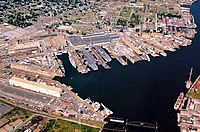
Aerial view of Norfolk Naval Shipyard
Newport News Shipbuilding, (formerly Northrup Grumman Newport News) is the largest private ship builder in the US and the one best known for its unique capacity to build the Nimitz-class aircraft carriers.
Ingalls Shipbuilding, part of Huntington Ingalls Industries, located in Pascagoula, Mississippi repaired the USS Cole and builds offshore drilling rigs, cruise ships and naval vessels.
National Steel and Shipbuilding Company (NASSCO) shipyard in San Diego, California, part of General Dynamics; is the primary shipbuilding location on the west coast of the United States.
Norfolk Naval Shipyard in Portsmouth, Virginia, is one of the largest shipyards in the world; specializing in repairing, overhauling and modernizing naval ships and submarines. It's the oldest and largest industrial facility that belongs to the United States Navy
Electric Boat Division (EBDiv) of General Dynamics in Groton, Connecticut with an accessory facility in Quonset Point, Rhode Island, builder of many Naval submarines over the past 100 years, with some types built only here.
Bath Iron Works (BIW), subsidiary of General Dynamics, is a major American shipyard located on the Kennebec River in Bath, Maine.
Puget Sound Naval Shipyard in Bremerton, Washington, is also owned by the U.S. Navy. It services ships and submarines from the West Coast.- The Portland, Oregon shipyard, operated by Cascade General Ship Repair (which is owned by Vigor Industrial)[4] is the largest such facility on the United States West Coast.
- The Louisiana Port is along the Mississippi river. It involves the Bollinger company in St. Rose.
- Talleres Navales del Golfo (TNG) at the Port of Veracruz, Mexico. Member of the Hutchison Port Holdings Group[5]
South America
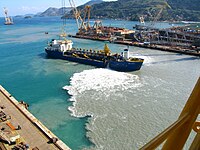
Brasfels Shipyard – Rio de Janeiro
- The DIANCA shipyard in Puerto Cabello, Venezuela.
- SCRA[6] (Construction Refurbishment and Armament Service) with two dry docks, ready for naval and general vessel works.
- Punta de Lobos (Wolves Point) in west Montevideo, established in 1874.
- Punta Maua (Maua Point) in east Montevideo, established in 1872.
- Tsakos Industrias Navales S.A.[7]
- Cotecmar shipyard in Cartagena, Colombia. Cotecmar
- Enseada Industria Naval S.A., Bahia and Rio de Janeiro, Brazil
- The SIMA shipyard in Callao, Peru.
- Asenabra, in Duran, Ecuador. Established in 1990, more than 25 years of experience in naval repairs. 72.000m2 operating today, dry dock facilities will be available in 2016.
ASMAR shipyards in Valparaiso, Talcahuano and Punta Arenas, Chile. ASMAR
Europe
Riga Shipyard is in Riga, Latvia. Established in 1913 and revived after both world wars, it remains one of the largest shipyards in the Baltic region.
Ferguson Shipbuilders is in Port Glasgow in inverclyde Scotland on the River Clyde. The Ferguson yard has been building ships for over a 110 years

Girvan shipyard Alexander Noble and son, Ayrshire Scotland
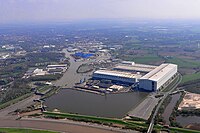
Meyer Werft shipyard in Papenburg, Germany
BAE Systems Surface Ships operates three shipbuilding yards in the United Kingdom; Portsmouth, England and Scotstoun and Govan on the River Clyde in Glasgow, Scotland. Major projects include the Type 45 destroyer and the Queen Elizabeth class aircraft carriers.
BAE Systems Submarine Solutions operates a major shipyard at Barrow-in-Furness in Cumbria, England. It is one of the few yards in the world capable of building nuclear submarines such as the Royal Navy's Vanguard class. Preceding companies such as Vickers Shipbuilding and Engineering have constructed hundreds of surface ships and civilian vessels in Barrow since the late 19th century.
Fincantieri – Cantieri Navali Italiani S.p.A.[8] is an Italian shipbuilding company based in Trieste, Italy. It was formed in 1959 and is the largest shipbuilder in Europe, and one of the largest in the world. The company has built both commercial and military vessels during its history.
Lürssen (or Lürssen Werft) is a German shipbuilding company based in Bremen-Vegesack. Lürssen designs and constructs yachts, naval ships and special vessels. Trading as Lürssen Yachts, it is one of the leading builders of custom superyachts.
Chantiers de l'Atlantique in Saint-Nazaire- Odense lindø Shipyard
- Finland STX
- Russian shipyards in Vyborg, Kronstadt NovoAdmirality, Admiralty, Baltic Verf, Severnaja Verf, Sevmash, Kaliningrad Baltic Verf, Murmansk areas, Zvezda and Vostok Raffles near Vladivostok along Dalzavod, Azovskaja SudoVerf and Zaliv, More, Sevastopol SMZ are some of the main shipyards included the largest ones.
- Kiel HDW
- Amsterdam Shipyards
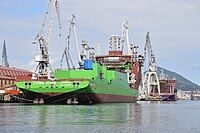
LaNaval shipyard in Bilbao, Spain
- Hamburg Shipyards
- Emden Shipyard
- The Meyer Werft GmbH is one of the major German shipyards, headquartered in Papenburg at the river Ems. Founded in 1795 and starting with small wooden vessels, today Meyer Werft is one of world's leading builders of luxury passenger ships. Altogether about 700 ships of different types have been built at the yard.
Navantia: major public Spanish shipbuilding firm, which offers its services to both military and civil sector in three industrial areas: Cartagena / Cádiz / Ferrol (headquarters: Madrid) and with recent important projects as F100 class frigate progam and S80 class submarine program- Construcciones Navales del Norte LaNaval, Sestao (Bilbao)
- Cernaval
- Lisnave: repair facilities in Setúbal (Lisbon, Portugal)
Navantia-Cartagena shipyard (Spain)
Devonport Dockyard, located in the city of Plymouth, England in the county of Devon is the largest naval base in Western Europe. It has 15 dry docks, four miles (6 km) of waterfront, 25 tidal berths, five basins and covers 650 acres (2.6 km2). It is the main refitting base for Royal Navy nuclear submarines and also handles work on frigates. It is the base for seven of the Trafalgar class nuclear-powered hunter-killer submarines and many frigates, exploiting its convenient access to the Atlantic Ocean. It supports the Vanguard class Trident missile nuclear ballistic missile submarines in a custom-built refitting dock. It houses HMS Courageous, a nuclear-powered submarine used in the Falklands War and open to the general public.[9] Facilities in the local area also include a major naval training establishment and a base for the Royal Marines.
Chatham Dockyard, located on the River Medway in Kent, was established as a royal dockyard by Queen Elizabeth I in 1567. For 414 years, the Dockyard provided over 500 ships for the Royal Navy, and was forefront of shipbuilding, industrial and architectural technology. At its height, it employed over 10,000 skilled artisans and covered 400 acres (1.6 km2). The dockyard closed in 1984, and most of the Georgian dockyard is now managed as a visitor attraction by the Chatham Historic Dockyard Trust.
Sobrena in Brest, France. It operates 3 drydocks, up to 420 by 80 metres.
Constanţa Shipyard in Romania on the shores of the Black Sea Basin.
Mangalia Shipyard again in Romania, 45 km south of the port of Constanța.
Galați shipyard Galați is the largest naval shipyard on the Danube, given its strategic positioning inland but with access to the sea through either Sulina or Danube-Black Sea canal its output ranges from large tankers to research vessels, yachts and small coast guard patrol boats. The yard is known for taking on specialty projects and under Damen has completed over such 250 vessels since 1999.
East Asia
Kawasaki Shipbuilding Corporation's Kobe Shipyard & Machinery Works in Japan builds oil tankers, LNG carriers, bulk carriers, container ships, Ro/Ro vessels, jetfoils and warships for the Japan Maritime Self-Defense Force
Mitsui Engineering & Shipbuilding's Tamano Works builds bulk carriers, ore carriers, crude oil tankers, oil product carriers, LNG carriers, LPG carriers, reefers, container ships, pure car carriers, cargo ships, patrol vessels, ocean surveillance ships, training vessels, fishery patrol boats and fishing boats
Mitsubishi Heavy Industries's Nagasaki Shipyard & Machinery Works primarily produces specialized commercial vessels, including LNG carriers, oil tankers and passenger cruise ships
Hyundai Heavy Industries Ulsan Shipyard & Gunsan shipyard, in South Korea, is currently the largest in the world and has the capability to build a variety of vessels including Commercial Cargo, FPSO offshore, container ship, LNG Carrier, Car carriers, Tankers like VLCC & ULCC, Iron ore carrier and Naval vessels like Aegis destroyers & submarines.
Hyundai Samho Heavy Industries Samho shipyard near Mokpo 4th largest South Korean shipyard for VLCC Oil tankers, container ships & LNG, Offshore, Subsidiary of Hyundai heavy industries.
Hyundai Mipo dockyard, Ulsan bay shipyard chemical ships, LPG carriers, Special ships. Subsidiary of Hyundai Heavy Industries
CSBC Corporation, Taiwan,in Taiwan,is a private company that produces ships for civilian and military use. It was a state-owned enterprise of Taiwan (Republic of China) but transitioned to private ownership via an IPO in 2008. It is headquartered in Kaohsiung and shipyards in Kaohsiung and Keelung.
Yantai Raffles Shipyard, in Yantai, China, is that country's largest offshore builder. It employs the 20,000 ton crane Taisun, the holder of the Heavy Lift World Record.[10] Yantai Raffles' portfolio includes offshore platforms, pipe lay and other specialized vessels.
Jiangnan Shipyard, in Shanghai, China, is a subsidiary of China State Shipbuilding Corporation that produces both military and civilian ships. Its headquarters and main shipyard are based in Shanghai, with subsidiary shipyards in Shanghai and Chongqing.
Bohai Shipyard, in Huludao, China, is a subsidiary of China Shipbuilding Industry Corporation that produces military (including nuclear powered vessels) and civilian ships.
South East Asia
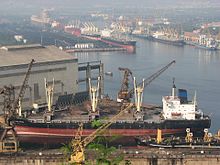
Visakhapatnam Shipyard
Keppel Shipyard(Singapore)- Jurong Shipyard Pte Ltd[11] (Singapore)
- Penguin Shipyard International, a subsidiary of Penguin International Limited[12] (Singapore)
Hanjin shipyard in Subic, Zambales, Philippines- Selat Melaka Shipbuilding Corporation[13] (Malaysia)
- PT Surya Prima Bahtera Heavy Industries,[14] in Batam, Indonesia.
The Bangkok Dock Company[15]Sattahip, Thailand- Marsun Company Limited (MCL)[16]Samutprakarn, Thailand
- Marine Acme Thai Dockyard (MAT)[17]Samutprakarn, Thailand
Bason Shipyard, in Ho Chi Minh City, Vietnam, is a long-standing builder that was established by the French government in April, 1863 to repair warships and merchant vessels. Aside from its main function of building and repairing naval vessels, Bason also offers service to local and foreign customers from Southeast Asia and Europe.[18]
PT. Dok Duasatu Nusantara in Jakarta, Indonesia.- PT Kim Seah Shipyard Indonesia in Batam, Indonesia, a subsidiary of Penguin International Limited.[19]
- PT Karyasindo Samudra Biru Shipyard in Batam, Indonesia, a well-established steel and aluminium shipbuilder in the region.[20]
South Asia and the Middle East
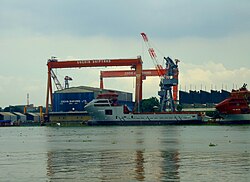
Cranes in Cochin Shipyard (India).

Dhaka Shipyard

Dhaka Shipyard – welding propellers
- Haque Dockyard, situated in the capital Dhaka, one of the oldest and trusted name in shipbuilding sector of Bangladesh.
- Lavgan Dockyard Pvt. Ltd. India's newest ship repair facility (operational from June 2014). 106m x 26m Syncrolift and side transfer system.
Western Marine Shipyard, a leading shipyard in Bangladesh based in Chittagong. The shipyard has been exporting ships and vessels to a number of European, Asian and African countries.
Khulna Shipyard is the oldest shipyard in Bangladesh, situated in Khulna. It mainly produces warships for Bangladesh Navy. Recently it also started to build commercial vessels like cargo ship, container, oil tanker for local buyers.
Ananda Shipyard and Shipways, one of the largest shipyards in Bangladesh, located in Narayanganj. It is a 100% export oriented shipyard.
Pipavav Shipyard in Gujarat, India, is the leading, modern and largest engineering facility in the business of ships and offshore platforms construction, repair and conversion, heavy engineering and offshore engineering in South Asia.
Colombo Dockyard in Colombo, Sri Lanka, is the largest engineering facility in the business of ship repair, shipbuilding, heavy engineering and offshore engineering in Sri Lanka.- NorthStar Shipbuilding Pvt Limited[21] in New Mumbai, India, is one of the leading shipyard in India for small and mid-size ships.
- Sulkha Shipyard[22] builds a wide variety of ships. It has been in operation for 500 years.
Cochin Shipyard in Kochi, India, is that country's largest shipyard. It is building the Vikrant class aircraft carrier.
Garden Reach Shipbuilders and Engineers is located in India. It is owned by the Government of India and is constructing the Shardul class Large landing ship tank for the Indian Navy.
Karachi Shipyard and Naval Dockyard in Karachi, Pakistan, is that country's first and oldest yard. It constructs cargo ships, tugboats, support vessels, and warships.
Mazagaon Dockyard, operated by state-owned Mazagaon Dock Limited, is one of India's largest shipyards. It constructs a variety of ships both for the defence and civilian sector. The dockyard is known for constructing Britain's HMS Trincomalee. Currently the shipyard is building three Shivalik class frigates and three Kolkata class destroyers for the Indian Navy.- The beach at Alang in the Indian state of Gujarat is the site of a large complex of shipbreaking yards. In 2010, the yard dismantled 357 ships; on average the yard processes 28–30 ships a month.[23]
- The Jebel Ali and Dubai ports in the UAE are capable of handling, constructing and repairing large ships. They also provide dry dock facilities.[24]
- The gate 7 of Shuwaikh port in the Kuwait has facility for repairing ships. They also provide dry dock facilities.[25]
- Lavgan Dockyard Pvt. Ltd. India's newest ship repair facility (operational from June 2014). 106m x 26m Syncrolift and side transfer system.
See also
- List of shipbuilders and shipyards
- Shipbuilding
References
^ ab Choi, J. Y., Hong, G. H., Ra, K., Kim, K., & Kim, K. (2014). "Magnetic characteristics of sediment grains concurrently contaminated with TBT and metals near a shipyard in Busan, Korea". Marine Pollution Bulletin. 85 (2): 679–685. doi:10.1016/j.marpolbul.2014.03.029.CS1 maint: Uses authors parameter (link).mw-parser-output cite.citationfont-style:inherit.mw-parser-output .citation qquotes:"""""""'""'".mw-parser-output .citation .cs1-lock-free abackground:url("//upload.wikimedia.org/wikipedia/commons/thumb/6/65/Lock-green.svg/9px-Lock-green.svg.png")no-repeat;background-position:right .1em center.mw-parser-output .citation .cs1-lock-limited a,.mw-parser-output .citation .cs1-lock-registration abackground:url("//upload.wikimedia.org/wikipedia/commons/thumb/d/d6/Lock-gray-alt-2.svg/9px-Lock-gray-alt-2.svg.png")no-repeat;background-position:right .1em center.mw-parser-output .citation .cs1-lock-subscription abackground:url("//upload.wikimedia.org/wikipedia/commons/thumb/a/aa/Lock-red-alt-2.svg/9px-Lock-red-alt-2.svg.png")no-repeat;background-position:right .1em center.mw-parser-output .cs1-subscription,.mw-parser-output .cs1-registrationcolor:#555.mw-parser-output .cs1-subscription span,.mw-parser-output .cs1-registration spanborder-bottom:1px dotted;cursor:help.mw-parser-output .cs1-ws-icon abackground:url("//upload.wikimedia.org/wikipedia/commons/thumb/4/4c/Wikisource-logo.svg/12px-Wikisource-logo.svg.png")no-repeat;background-position:right .1em center.mw-parser-output code.cs1-codecolor:inherit;background:inherit;border:inherit;padding:inherit.mw-parser-output .cs1-hidden-errordisplay:none;font-size:100%.mw-parser-output .cs1-visible-errorfont-size:100%.mw-parser-output .cs1-maintdisplay:none;color:#33aa33;margin-left:0.3em.mw-parser-output .cs1-subscription,.mw-parser-output .cs1-registration,.mw-parser-output .cs1-formatfont-size:95%.mw-parser-output .cs1-kern-left,.mw-parser-output .cs1-kern-wl-leftpadding-left:0.2em.mw-parser-output .cs1-kern-right,.mw-parser-output .cs1-kern-wl-rightpadding-right:0.2em
^ abc Walker, G., Hanna, J., & Allen, S. (2005). "Treatment of hazardous shipyard wastewater using dolomitic sorbents". Water Research. 39 (11): 2422–2428. doi:10.1016/j.watres.2005.04.025.CS1 maint: Uses authors parameter (link)
^ abc Wurzelbacher, S. J., Hudock, S. D., Johnston, O. E., Blade, L. M., & Shulman, S. A. (2002). "A Pilot Study on the Effects of Two Ventilation Methods on Weld Fume Exposures in a Shipyard Confined Space Welding Task". Applied Occupational and Environmental Hygiene. 17 (11): 735–740. doi:10.1080/10473220290096069.CS1 maint: Uses authors parameter (link)
^ "Vigor Marine". Vigor Industrial. Archived from the original on July 22, 2012. Retrieved July 6, 2012.
^ "Company (about us)". TNG. Archived from the original on April 2, 2015. Retrieved March 2, 2015.
^ "SCRA". SCRA. Archived from the original on November 8, 2012. Retrieved July 6, 2012.
^ "TSK". Tsakos Industrias Navales S.A. Archived from the original on June 20, 2012. Retrieved July 6, 2012.
^ E-mail * Saisissez votre adresse électronique. "STX Europe démantelé, Fincantieri va devenir le géant européen de la navale" (in French). Mer et Marine. Archived from the original on 2013-05-02. Retrieved 2013-04-30.
^ "Submarine Museum marks Falklands 30th anniversary". BBC. May 2, 2012. Archived from the original on June 14, 2012.
^ "Yantai Raffles' world-record gantry crane should see first lift this year – Offshore". Offshore-mag.com. Retrieved 2012-05-19.
^ "Jurong Shipyard Pte Ltd". Jurong Shipyard Pte Ltd. Archived from the original on May 6, 2014. Retrieved May 6, 2014.
^ "Penguin Shipyard International". Archived from the original on 2016-08-18.
^ "Selat Melaka Shipbuilding Corporation". Selat Melaka. Archived from the original on July 11, 2012. Retrieved July 6, 2012.
^ "Surya Prima Bahtera Heavy Industries". SPB. Archived from the original on July 14, 2012. Retrieved July 6, 2012.
^ "The Bangkok Dock Company (1957) Limited". The Bangkok Dock Company. Archived from the original on March 14, 2013. Retrieved July 6, 2012.
^ "Marsun Company Limited". Marsun Company Limited. Archived from the original on August 18, 2012. Retrieved July 6, 2012.
^ "Marine Acme Thai Dockyard". MAT. Archived from the original on May 25, 2012. Retrieved July 6, 2012.
^ "Bason Shipyard's Brief History" (in Vietnamese). Bason Shipyard Website. Archived from the original on March 3, 2016. Retrieved March 29, 2013.
^ "PT Kim Seah Shipyard Indonesia". Archived from the original on 2016-08-11.
^ "PT Karyasindo Samudra Biru Shipyard Indonesia". Archived from the original on 2016-12-20.
^ "NorthStar Shipbuilding Pvt Ltd". NorthStar Shipbuilding Pvt Ltd. Archived from the original on July 6, 2012. Retrieved July 6, 2012.
^ "Sulkha Shipyard". Sulkha Shipyard. Archived from the original on March 30, 2012. Retrieved July 6, 2012.
^ "Alang ship-breakers face Rs 2,000-cr hit from Rupee fall". The Economic Times. January 13, 2012. Archived from the original on November 14, 2013.
^ world, Drydocks. "Drydocks World - Contacts". www.drydocks.gov.ae. Archived from the original on 6 May 2018. Retrieved 6 May 2018.
^ "HOME". www.heisco.com. Archived from the original on 24 February 2018. Retrieved 6 May 2018.
External links
| Wikimedia Commons has media related to Shipyards. |
This article's use of external links may not follow Wikipedia's policies or guidelines. (January 2017) (Learn how and when to remove this template message) |
Drassanes at Barcelona – The Drassanes shipyard in Barcelona, with some original buildings dating to the 13th century.
India based shipyards – India based shipyard.
Sea Your History – Website from the Royal Naval Museum – Discover detailed information about Portsmouth Dockyard and the Royal Navy in the 20th century.
U.S. Shipyards – extensive collection of information about U. S. shipyards, including over 500 pages of U. S. shipyard construction records
Trading Places – interactive history of European dockyards
Shipyards United States – from GlobalSecurity.org- Gold Coast City Marina & Shipyard
European shipyards – shipbuilding history in Hungary, Czechoslovakia and Slovakia

